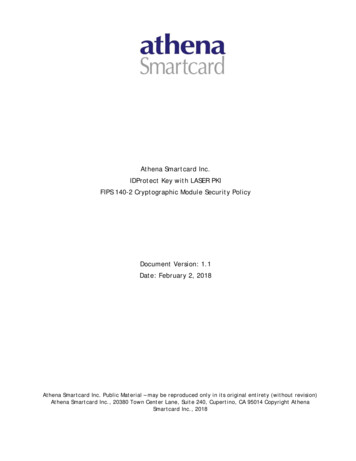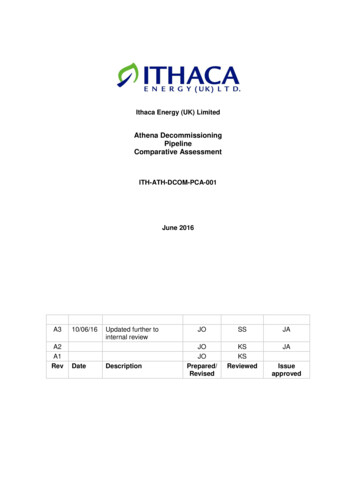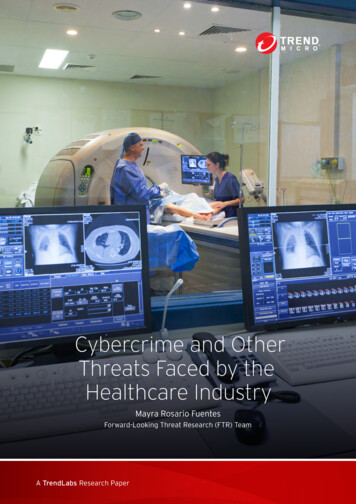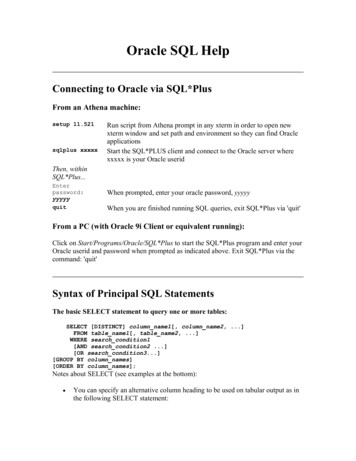
Transcription
Athena Smartcard Inc.IDProtect Key with LASER PKIFIPS 140-2 Cryptographic Module Security PolicyDocument Version: 1.1Date: February 2, 2018Athena Smartcard Inc. Public Material – may be reproduced only in its original entirety (without revision)Athena Smartcard Inc., 20380 Town Center Lane, Suite 240, Cupertino, CA 95014 Copyright AthenaSmartcard Inc., 2018
Athena Smartcard Inc. IDProtect Key with LASER PKIFIPS 140-2 Security PolicyTable of ContentsTable of Contents. 2Table of Tables . 4Table of Figures. 51Introduction . .399.19.29.2.19.2.2General.High-Level Module Architecture.Java Card API .Structure of this Security Policy .6666FIPS 140-2 Security Levels . 7Hardware and Physical Cryptographic Boundary. 8Physical Security Policy . 9Ports and Interfaces. 9USB. 9Firmware and Logical Cryptographic Boundary . 10Operational Environment. 10Versions . 10FIPS 140-2 Compliance (Platform) . 11Cryptographic Functionality . 11Critical Security Parameters . 12Public Keys . 13Error States . 13Key and CSP Zeroization. 13Self-Tests . 14Power-On Self-Tests . 14Conditional Self-Tests . 14Standards Compliance . 15Roles, Authentication and Services (Platform) . 16General. 16Roles . 16Authentication . 16Services . 17Unauthenticated Services . 17Authenticated Services . 18Approved Mode of Operation (Platform) . 19Verification of Approved Mode . 19FIPS 140-2 Compliance (Applet) . 20LASER PKI Applet Description . 20Critical Security Parameters . 20Public keys. 20Roles, Authentication and Services (Applet) . 22Roles . 22Authentication . 22LASER PKI Applet PIN Comparison Authentication . 22LASER PKI Applet PIN Comparison Confidentiality . 23Athena Smartcard Inc. Public MaterialCopyright Athena Smartcard Inc., 2018Version 1.1Page 2 of 34
Athena Smartcard Inc. IDProtect Key with LASER 5.315.4FIPS 140-2 Security PolicyLASER PKI Applet Symmetric Cryptographic Authentication. 24Services . 25Unauthenticated Services . 25Authenticated Services . 25Approved Mode of Operation (Applet) . 27Verification of Approved Mode . 27Operational Environment. 28Electromagnetic Interference and Compatibility (EMI/EMC) . 29Mitigation of Other Attacks Policy . 30Security Rules and Guidance . 31Security Rules (General) . 31References. 32Acronyms . 32References (Cryptography) . 32References (Platform) . 33References (Applet) . 34Athena Smartcard Inc. Public MaterialCopyright Athena Smartcard Inc., 2018Version 1.1Page 3 of 34
Athena Smartcard Inc. IDProtect Key with LASER PKIFIPS 140-2 Security PolicyTable of TablesTable 1 – Security Level of Security Requirements .7Table 2 – USB Physical Interfaces .9Table 3 – USB Logical Interfaces .9Table 4 – FIPS Approved Cryptographic Functions .11Table 5 – Non-FIPS Approved But Allowed Cryptographic Functions .12Table 6 - Critical Security Parameters (Platform) .12Table 7 - Public Keys (Platform) .13Table 8 – Error States .13Table 9 – Power-On Self-Test .14Table 10 – Roles (Platform) .16Table 11 - Unauthenticated Services and CSP Usage .17Table 12 – Authenticated Services and CSP Usage .18Table 13 – Versions and Mode of Operations Indicators .19Table 14 - Critical Security Parameters (Applet) .20Table 15 - Public Keys (Applet) .21Table 16 – Roles (Applet).22Table 17 – Authenticated Services and CSP Usage .26Table 18 – References (Cryptography) .33Table 19 – References (Platform) .33Table 20 – References (Applet) .34Athena Smartcard Inc. Public MaterialCopyright Athena Smartcard Inc., 2018Version 1.1Page 4 of 34
Athena Smartcard Inc. IDProtect Key with LASER PKIFIPS 140-2 Security PolicyTable of FiguresFigure 1 – TIDPTMINI72 Hardware and Physical Cryptographic Boundary .8Figure 2 – TIDPUSBV2J Hardware and Physical Cryptographic Boundary .8Figure 3 - Module Block Diagram .10Athena Smartcard Inc. Public MaterialCopyright Athena Smartcard Inc., 2018Version 1.1Page 5 of 34
Athena Smartcard Inc. IDProtect Key with LASER PKIFIPS 140-2 Security Policy1 Introduction1.1 GeneralThis document defines the Security Policy for the Athena Smartcard Inc. IDProtect Key with LASER PKICryptographic Module, hereafter denoted the Module. The Module is validated to FIPS 140-2 Level 3.This document contains a description of the Module, its interfaces and services, the intended operatorsand the security policies enforced in the approved mode of operation.1.2 High-Level Module ArchitectureThe Module is a single chip smart card micro-controller. The Module architecture consists of two HighLevel architectural components: Platform (Card Manager and GlobalPlatform operational environment)LASER PKI AppletThe purpose of the GlobalPlatform operational environment is to provide common smart card operationalenvironment facilities and services in accordance with the GlobalPlatform Specification. The CardManager manages the Applet Life Cycle state.The GlobalPlatform external interface and internal API allows for Applet loading and unloading, for securecommunication between an Applet and a terminal and for the use of a PIN in the context of the entireModule. In particular, it allows for the loading of a special Applet called a Supplementary Security Domainthat allows an Application Provider to separate their key space from the Card Manager.The purpose of the Applet is to provide services to the end user according to the user productrequirements.According to the requirements of FIPS 140-2 both the Platform and the Applet are tested during the FIPS140-2 conformance testing. The FIPS 140-2 conformance certificate is issued for a Cryptographic Module,which is a combination of the Platform and the Applet. For product upgrades, only FIPS 140-2 validatedApplets can be installed on the Module.1.3 Java Card APIThe Java Card API is an internal API utilized by the Applet in order to execute services provided by thePlatform. The Java Card API is not exposed to external applications or end users.1.4 Structure of this Security PolicyAs the Module is logically separated into the Platform and the Applet, this Security Policy documentlogically separates FIPS 140-2 related information items into Platform-specific information (see Sections 57) and Applet-specific information (see Sections 8-10). The required FIPS 140-2 information should then beviewed as a superposition of the Platform-specific and Applet-specific Information Items.Athena Smartcard Inc. Public MaterialCopyright Athena Smartcard Inc., 2018Version 1.1Page 6 of 34
Athena Smartcard Inc. IDProtect Key with LASER PKIFIPS 140-2 Security Policy2 FIPS 140-2 Security LevelsThe FIPS 140-2 security levels for the Module are as follows:Security RequirementSecurity LevelCryptographic Module Specification3Cryptographic Module Ports and Interfaces3Roles, Services, and Authentication3Finite State Model3Physical Security3Operational EnvironmentN/ACryptographic Key Management3EMI/EMC3Self-Tests3Design Assurance3Mitigation of Other Attacks3Table 1 – Security Level of Security RequirementsAthena Smartcard Inc. Public MaterialCopyright Athena Smartcard Inc., 2018Version 1.1Page 7 of 34
Athena Smartcard Inc. IDProtect Key with LASER PKIFIPS 140-2 Security Policy3 Hardware and Physical Cryptographic BoundaryThe Module is a single-chip implementation that meets commercial-grade specifications for power,temperature, reliability, and shock/vibrations. The Module is a USB token with two package options, asshown in Figures 1 and 2. The physical boundary of the module is the outer enclosure of the token and theUSB connector. The single chip is packaged in an 8 pin SOIC with standard passivation techniques,mounted on a PCB assembly with the SOIC package covered in epoxy, and further protected by a hardenclosure for both package types. The PCB assembly includes only the single IC; the passives, crystalresonator, PCB assembly and the USB token cap are excluded from the security requirements.If malfunctioning or misused, the excluded components cannot cause a compromise under any reasonablecondition. The cap is cosmetic with no security function. Opacity is provided in multiple layers, includingthe opaque epoxy, the SOIC package and layers of active and passive shielding (metal layer coveringsopaque to the circuitry below) on the die. Enclosure hardness is provided in multiple layers, including theouter enclosure, the epoxy and the SOIC package. Tamper evidence is provided by the outer enclosure:the tamper evidence inspection policy is described below. The die's active shielding provides a tamperresponse mechanism: a tamper event detected by the active shield places the Module permanently in the“Tamper is detected” error state. The Module also provides a transport key to protect against tamperingduring manufacturing and the protections listed in Section 10 below.The Module hardware and physical cryptographic boundary is pictured below:Figure 1 – TIDPTMINI72 Hardware and Physical Cryptographic BoundaryFigure 2 – TIDPUSBV2J Hardware and Physical Cryptographic BoundaryNote that for the TIDPUSBV2J the color of the collar and/or the embossed brand name may be different.This does not change the physical security or the part number.Athena Smartcard Inc. Public MaterialCopyright Athena Smartcard Inc., 2018Version 1.1Page 8 of 34
Athena Smartcard Inc. IDProtect Key with LASER PKIFIPS 140-2 Security Policy3.1 Physical Security PolicyThe operator shall inspect the Module for tamper evidence prior to each usage: Tamper evidence for the TIDPTMINI72 configuration is determined by the non-removable housingcovers. If the covers are easily separated the Module may have been tampered with and shall notbe used.Tamper evidence for the TIDPUSBVJ2 configuration is determined by inspection of the outerenclosure. If it is damaged with holes or gaps in the outer enclosure the Module may have beentampered with and shall not be used.3.2 Ports and InterfacesThe Module functions as a slave processor to process and respond to commands.The Module also contains an ISO/IEC 7816 interface but this interface is non-operational (no data or statusinput or output can occur on this interface) as the module does not use IN/OUT0 for Data In/Data Out noruse CLK or RST for Control In.3.2.1 USBThis module provides a contact interface that is fully compliant with USB 2.0. There is an LED thatindicates USB activity independent of the single chip smart card micro-controller.InterfaceDescriptionUSBDMUSB D- differential dataUSBDPUSB D differential dataXINCrystal (resonator) signal inputXOUTCrystal (resonator) signal outputVBusPower supply inputGNDGround (reference voltage)LEDIndicates USB activityTable 2 – USB Physical InterfacesISO/IEC 7816-4 compliant commands are enveloped into the vendor-specific requests (VSR) and passed tothe device via USB Control Transfer Endpoint 0.The module supports four USB protocols: CCID, eToken, HID and Mass storage.The I/O ports of the platform provide the following logical interfaces:InterfaceUSBData InUSBDM, USBDPData OutUSBDM, USBDPStatus OutUSBDM, USBDP, LEDControl InUSBDM, USBDP, XIN, XOUTTable 3 – USB Logical InterfacesAthena Smartcard Inc. Public MaterialCopyright Athena Smartcard Inc., 2018Version 1.1Page 9 of 34
Athena Smartcard Inc. IDProtect Key with LASER PKIFIPS 140-2 Security Policy4 Firmware and Logical Cryptographic Boundary4.1 Operational EnvironmentFigure 2 depicts the Module operational environment. The Applet in the figure is the LASER PKI Applet.CardManagerAppletGlobalPlatform operational environmentHardwarePowerMgmtMMUControl InClockMgmtRAMControl InReset MgmtEEPROMCRCCryptoEnginesTimersCPUControl InIOSensorsROMHW RNGData In, Data OutStatus OutFigure 3 - Module Block Diagram 72 KB EEPROM; 256 KB ROM; 8 KB RAM4.2 VersionsThe hardware and firmware version numbers for the Module are provided below:Hardware: Inside Secure AT90SC25672RCT-USB Rev. D packaged in TIDPTMINI72 and TIDPUSBV2JFirmware: Athena IDProtect 0106.0130.0401 with LASER PKI Applet 3.0Athena Smartcard Inc. Public MaterialCopyright Athena Smartcard Inc., 2018Version 1.1Page 10 of 34
Athena Smartcard Inc. IDProtect Key with LASER PKIFIPS 140-2 Security Policy5 FIPS 140-2 Compliance (Platform)5.1 Cryptographic FunctionalityThe Module implements the FIPS Approved and Non-FIPS Approved But Allowed cryptographic functionslisted in tables below.AlgorithmDescriptionCertificate #DRBG[SP800-90] DRBG. The Module supports a SHA-256 basedHash DRBG.98SHA[FIPS180-3] Secure Hash Standard compliant one-way(hash) algorithms. The Module supports SHA-1, SHA-224,SHA-256, SHA-384 and SHA-512.1465TDES[SP800-67] Triple Data Encryption Algorithm. The Modulesupports the 2-Key and 3-Key options; in ECB and CBCmodes.1087TDES MAC[FIPS113] TDES Message Authentication Code. Vendoraffirmed, based on validated TDES.Vendor Affirmed(TDES Certificate #1087)AES[FIPS197] Advanced Encryption Standard algorithm. TheModule supports AES-128, AES-192 and AES-256; in ECBand CBC modes.1654AES CMAC[SP800-38B] AES CMAC (untested). The Module supportsAES CMAC with AES-128, AES192 and AES-256 forGlobalPlatform SCP03.Vendor Affirmed (AESCertificate 1654)KTS[SP800-38F] AES Key Wrap using 128, 192, or 256 bit keys,meets the SP800‐38F §3.1 ¶3, combination method ofCert. #1654 AES and Vendor Affirmed AES-CMAC.Key establishment methodology provides between 128 and256 bits of encryption strength.1654RSA[FIPS186-2] RSA signature generation and verification.The Module supports [PKCS#1] RSASSA-PSS andRSASSAPKCS1-v1 5 with 1024- and 2048-bit RSA keys.824ECDSA[FIPS186-3] Elliptic Curve Digital Signature Algorithm. TheModule supports the NIST defined P-256 and P-384 curvesfor signature generation and verification, and key pairgeneration.The Module also allows domain parameters as supplied bythe calling application for signature generation andverification, and key pair generation. The Moduleperforms domain parameter validity testing in accordancewith [FIPS186-3] and [SP800-89].214ECC CDH[SP800-56A] The Section 5.7.1.2 ECC CDH Primitive only.The module supports the NIST defined P-256 and P-384curves.2Table 4 – FIPS Approved Cryptographic FunctionsAthena Smartcard Inc. Public MaterialCopyright Athena Smartcard Inc., 2018Version 1.1Page 11 of 34
Athena Smartcard Inc. IDProtect Key with LASER PKIFIPS 140-2 Security PolicyAlgorithmDescriptionHW RNGHardware RNG; minimum of 64 bits per access. The HW RNG output is used to seedthe FIPS approved DRBG.RSAANSI X9.31 RSA key pair generation (untested). The Module supports 1024- and 2048bit RSA key generation.EC DiffieHellman[SP800-131A] EC Diffie-Hellman. The module supports all NIST defined P curves.Table 5 – Non-FIPS Approved But Allowed Cryptographic Functions5.2 Critical Security ParametersPlatform-specific CSPs are specified below:KeyDescription / UsageOS-DRBG SEED384 bit random value from HW RNG used to seed theDRBGOS-DRBG STATE880 bit value of current DRBG stateOS-MKEKAES-128 key used to encrypt all secret and private keydata stored in EEPROMOS-PKEKAES-128 key used to encrypt all PINsISD-KENCAES-128, 192 or 256 key used by the CM role to deriveISD-SENC as specified by GlobalPlatform SCP03ISD-KMACAES-128, 192 or 256 key used by the CM role to deriveISD-SMAC and ISD-SRMAC as specified byGlobalPlatform SCP03ISD-KDEKAES-128, 192 or 256 data decryption key used by theCM role to decrypt CSPs as specified by GlobalPlatformSCP03ISD-SENCAES-128, 192 or 256 session encryption key used by theCM role to encrypt / decrypt Secure Channel Sessiondata as specified by GlobalPlatform SCP03ISD-SMACAES-128, 192 or 256 session MAC key used by the CMrole to verify inbound Secure Channel Session dataintegrity as specified by GlobalPlatform SCP03ISD-SRMACAES-128, 192 or 256 session MAC key used by the CMrole to verify outbound Secure Channel Session dataintegrity as specified by GlobalPlatform SCP03Table 6 - Critical Security Parameters (Platform)Athena Smartcard Inc. Public MaterialCopyright Athena Smartcard Inc., 2018Version 1.1Page 12 of 34
Athena Smartcard Inc. IDProtect Key with LASER PKI5.3FIPS 140-2 Security PolicyPublic KeysPlatform-specific public keys used by the Module are specified below:KeyDescription / UsageISD-DAPRSA 1024 GlobalPlatform Data Authentication Public Key used to verify the signature ofpackages loaded into the Module.Table 7 - Public Keys (Platform)5.4 Error StatesThe Module has three error states:Error stateDescriptionTamper is detectedThe hardware detects that it has been tampered with and will notpoweron. It is not possible to exit this state (it persists even after a reset:POWER OFF then POWER ON).CM is muteCM enters a state that forbids the execution of any further code. It ispossible to exit this state with a reset: POWER OFF then POWER ON.ISD is terminatedThe CSPs are zeroized and the Card Life Cycle state is set to TERMINATED.Only the GET DATA command can be processed. It is not possible to exitthis state (it persists even after a reset: POWER OFF then POWER ON).Table 8 – Error StatesThere also exists a transient error state when the module has received an unsupported, unrecognized orimproperly formatted command. The Module returns an error status word as specified in ISO/IEC 7816-4,exits the error state and returns to an idle state awaiting the next command.5.5 Key and CSP ZeroizationThe Module offers services to zeroize all CSPs in EEPROM: OS-MKEK and OS-PKEK are zeroized when the CM enters the “ISD is terminated” error state. TheCard Manager can achieve this explicitly using the SET STATUS command, or a severe securityevent may occur (failure of the integrity check on code located in EEPROM or of a CSP). Byzeroizing these keys all other CSPs stored in EEPROM are made irreversibly undecipherable.The Module offers services to zeroize all CSPs in RAM: Card Reset zeroizes all CSPs in RAM as the data values held in RAM are lost at power-off and RAM isactively cleared to zero at the next power-on.When a Secure Channel Session is closed for any reason other than Card Reset, the CM overwritesthe session keys with zeroes.By zeroizing OS-MKEK and OS-PKEK and performing a Card Reset all CSPs stored in the Module areeffectively destroyed.Athena Smartcard Inc. Public MaterialCopyright Athena Smartcard Inc., 2018Version 1.1Page 13 of 34
Athena Smartcard Inc. IDProtect Key with LASER PKIFIPS 140-2 Security Policy5.6 Self-Tests5.6.1 Power-On Self-TestsEach time the Module is powered on it tests that the cryptographic algorithms still operate correctly andthat sensitive data have not been damaged. Power-on self–tests are available on demand by power cyclingthe Module.On power-on the Module performs the self-tests described in Table 9 below. Every Known Answer Test(KAT) must be completed successfully prior to any other use of cryptography by the Module.The error state entered by the Module in case of power-on self-tests failure is “CM is mute”.Test TargetDescriptionFirmwareIntegrity16 bit CRC performed over all code located in EEPROM. This integrity test is not required orperformed for code stored in masked ROM code memory.DRBGPerforms the DRBG KAT.SHSPerforms separate SHA-1, SHA-256 and SHA-512 KATs.TDESPerforms separate encrypt and decrypt KATs using 3-Key TDES in CBC mode.AESPerforms separate encrypt and decrypt KATs using an AES-128 in CBC mode.RSAPerforms a KAT (RSA PKCS#1 sign and verify) using an RSA 2048 bit key pair.ECDSAPerforms a KAT (ECDSA sign and verify) using an ECC P-256 key pair.ECC CDHPerforms an ECC CDH KAT using an ECC P-256 key pair.Table 9 – Power-On Self-Test5.6.2 Conditional Self-TestsEach time the Module is powered on it performs the DRBG health test monitoring functions.On every generation of 64 bits of random data by the HW RNG the Module performs a stuck fault test toassure that the output is different from the previous value. In case of failure the Module enters the “CM ismute” error state.On every generation of 256 bits of random data by the DRBG, the Module performs a stuck fault test toassure that the output is different from the previous value. In case of failure the Module enters the “CM ismute” error state.When an asymmetric key pair is generated (for RSA or ECC) the Module performs a Pairwise ConsistencyTest (PCT). In case of failure the invalid key pair is zeroized and the Module enters the “CM is mute” errorstate.When a signature is generated (for RSA or ECDSA) the Module performs a PCT using the associated publickey. This PCT is also performed during the RSA and ECDSA KAT.Every CSP is protected with a 16 bit CRC. The integrity is checked when a CSP is used. In case of failurethe Module enters the “ISD is terminated” error state.When new firmware is loaded into the Module using the LOAD command, the Module verifies the integrityof the new firmware by verifying a signature of the new firmware using the ISD-DAP public key; the newfirmware in this scenario is signed by an external entity using the private key corresponding to ISD-DAP. Ifthe signature verification fails the Module returns an error and does not load the firmware.Athena Smartcard Inc. Public MaterialCopyright Athena Smartcard Inc., 2018Version 1.1Page 14 of 34
Athena Smartcard Inc. IDProtect Key with LASER PKIFIPS 140-2 Security Policy5.7 Standards ComplianceThe Platform and the Applet are compliant with various standards.The Module implementation is compliant with the following standards for the Platform: [JavaCard][GlobalPlatform][USB2.0]Athena Smartcard Inc. Public MaterialCopyright Athena Smartcard Inc., 2018Version 1.1Page 15 of 34
Athena Smartcard Inc. IDProtect Key with LASER PKIFIPS 140-2 Security Policy6 Roles, Authentication and Services (Platform)6.1 GeneralTable 10 lists all Platform-specific operator roles supported by the Module.The Module does not support a maintenance role.The Module supports concurrent operators on multiple Logical Channels. However, neither the ISD norLASER PKI Applet are multi-selectable (they cannot be simultaneously selected on two Logical Channels).Therefore there cannot be two concurrent operators using the ISD nor two concurrent operators using theLASER PKI Applet. It is however possible to select the ISD on the Basic Channel and the LASER PKI Appleton Supplementary Channel 1 (or vice versa).The Module clears previous authentications on po
Athena Smartcard Inc. IDProtect Key with LASER PKI FIPS 140-2 Security Policy . Athena Smartcard Inc. Public Material Version 1.1 Page 2 of 34 . LASER PKI Applet The purpose of the GlobalPlatform operational environment is to provide common smart card operational










